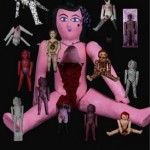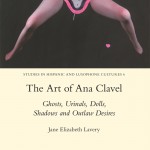-
Recent Posts
- CLLEAR seminar Friday 6th October: Prof Tania Ionin 26/09/2017
- TNS Workshop 6th July 19/06/2017
- CLLEAR Thurs 25th May @ 4pm: Prof Jennifer Smith and Dr Sophie Holmes-Elliot 22/05/2017
- CLLEAR Seminar Wednesday 17th May: Prof Alessandro Benati 11/05/2017
- CLLEAR Seminar Friday 5th May: Dr Neal Snape 27/04/2017
Archives
The art of Ana Clavel

Photo-collage of 14 dolls exhibited at Casa Refugio. Photo: Arturo Buitrón and Gabriel Macotela. Courtesy of Ana Clavel.
Ever since my undergraduate years at Cambridge University (1994-97), I have been fascinated by the representations of women and questions of gender in the fiction of Spanish American writing by female writers and in particular the writing of Mexican boom femenino writers (1970 -). Through my research in the form of three books and various peer-reviewed articles, it has become apparent to me that the writing of the boom femenino is informed by a deep tension. The writing of these female writers provides invaluable sociological insights into issues of gender inequality, the socio-historical marginalisation of women or other perceived minority groups such as gays or Jews, the (female) body, and sexuality in a broad Mexican context. However, so too is their writing often overshadowed by the fact that the boom femenino frequently carries derogatory connotations as it has become invariably linked to ‘commercialism,’ the concept of the ‘best-seller’ and by inference, ‘light writing’. The term ‘literatura light’ [‘light literature’] to refer to the work by some women writers in Spanish America has triggered heated discussions around concepts such as ‘women’s writing’ and the nature of literature and its place in a global world. My current work on Mexican multimedia writer Ana Clavel in the form of a monograph seeks to demonstrate how these questions continue to be of relevance to Mexican women’s writing and how boom femenino second generation writers such as Clavel are seeking to set themselves apart from their predecessors. Whilst second generation writers such as Clavel, Cristina Rivera-Garza or Ana García Bergua, for instance, see their work as broadly convergent with certain strands of the first generation of the Mexican boom femenino, such as their feminist principles which include notions of gender inequality as well as their focus on sexuality, the body and the voices of marginalised sectors of society, they consciously write works of fiction which are not of the best-seller type associated with certain Mexican women’s writing of the boom femenino.
The multimedia element of the work of Ana Clavel also reflects my own research trajectory. My latest publication will help me to continue to establish my expertise in the field of Mexican Cultural, Gender and literary Studies and, more recently, my interest in the concept of the Q/queer and multimedia. This latter term is applied specifically to the interrelationship between literature, the visual arts, performance, music and cyberculture. I examine the manner in which Clavel’s works are Q/queer in their examination as Ana Clavel is a remarkable contemporary Mexican writer whose literary and multimedia oeuvre is marked by its transgressive thrust and its queerness. That which steps beyond conventionally determined boundaries or the queer is evinced in the manner in which the author disturbs conceptions of the normal not only by representing ‘outlaw’ sexualities and ‘dark’ desires but also by incorporating into her fictive and multimedia worlds that which is at odds with normalcy as evinced in the presence of the fantastical, the shadow, ghosts, dolls, golems and even urinals. Clavel’s literary trajectory follows a queer path in the sense that she has moved from singular modes of creative expression in the form of literary writing, a traditional print medium, towards other non-literary forms. Her works embrace an array of hybrid forms including the audiovisual, internet-enabled technology, art installation, (video) performance and photography. By foregrounding the outlaw heterogeneous narrative themes, techniques and multimedia dimension of Clavel’s oeuvre, the aim of my monograph is to attest to her particular contribution to Hispanic letters, which arguably is as significant as that of more established Spanish American boom femenino women writers. Clavel’s work forms part of an exciting new trend in Latin America where other Spanish American writers who have also used multimedia such Doménico Chiappe or Mario Bellatin. One of the questions I am particularly interested in exploring in Clavel’s multimedia endeavours, is to seek to establish whether, in an age when the transformation of culture in the 21st century is being fuelled with new technologies and different media, so-called traditional written cultures are being threatened or enhanced by such innovations. In this study I will discuss the relationship between queerness, multimedia interventions and literature in Clavel’s works and her multimedia public persona. In doing so, this study might be seen as contributing towards a possible theoretical framework with which to conceptualise the emerging ‘canon’ of (Latin American) writers (and artists) and their personas working with literature, cyberspace and multimedia.
Thanks to an amicable professional relationship with Clavel, I have had privileged access to unpublished material which the author has supplied to me and is invaluable data which has contributed to the overall uniqueness of my study. In 2008 I was awarded a British Academy small grants award which allowed me to go to Mexico City to attend the multimedia exhibition based on of one of Clavel’s works (Las Violetas son flores del deseo (see image attached). I was directly involved in helping Clavel to set up the exhibition which gave me an important insight into how the author worked across a number of disciplines (art, performance, music, photography) as well as giving me access to the different people involved in this and Clavel’s other multimedia endeavours including web designers, performers, artists and photographers. The original data I obtained during my stay has allowed me to address in my work exiting lacunae in our understanding of Clavel’s work with an approach that is thematically and analytically innovative.
My monograph on Clavel, entitled The Art of Ana Clavel: Ghosts, Urinals, Dolls, Shadows and Outlaw Desires, will be published with Legenda, Oxford in November 2014 in its Studies in Hispanic and Lusophone Cultures 6, series. It has been widely publicised in the cultural supplements of various newspapers in Mexico including the leading El Universal.
http://www.southampton.ac.uk/ml/about/staff/jel2.page
The Art of Ana Clavel: Ghosts, Urinals, Dolls, Shadows and Outlaw Desires
Oxford: Legenda, November 2014
